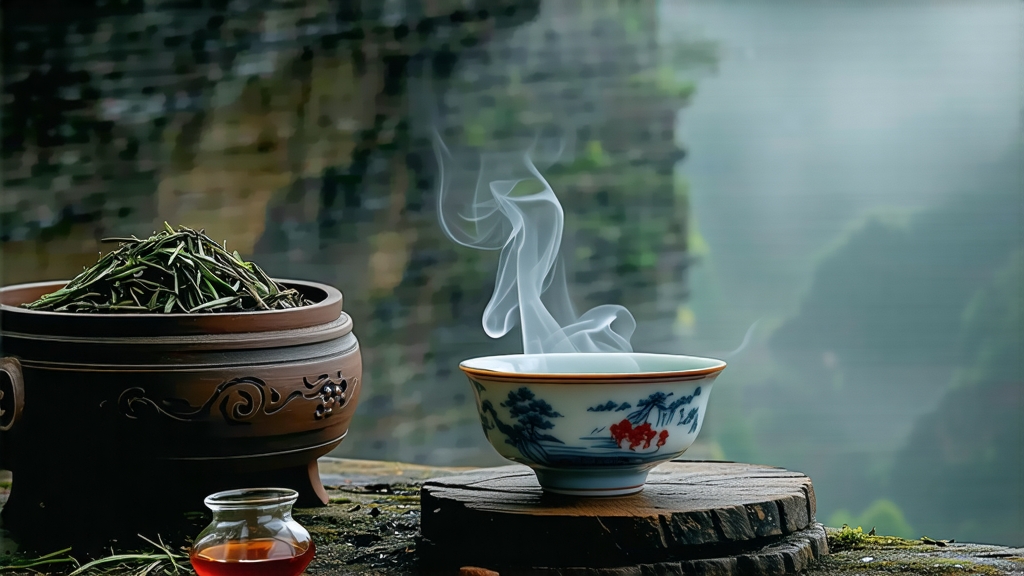
High in the rugged folds of the Wuyi Mountains of northern Fujian, where mist coils around basalt cliffs and every ravine carries the scent of pine resin and orchids, tea makers still follow a recipe that predates the Boston Tea Party. The tea is Lapsang Souchong—literally “small variety from Zhengshan,” the original protected core of Tongmu Village. To most outsiders the name evokes campfire in a cup, yet beneath the smoke lies a lineage so old that the Chinese word for “black tea” (hong cha, “red tea”) was coined to describe its copper-coloured infusion. This is the story of how a Qing-dynasty accident became the world’s first fully oxidised tea, how its flavour map ranges from pine ember to longan honey, and how you can coax those layers out in a quiet kitchen thousands of miles from the mountain.
-
A leaf born of flight
Legend places the birth moment in 1646, when Qing troops quartered themselves in Tongmu. To dry the fresh leaves before the soldiers returned, farmers spread them over pine fires. The smoke penetrated the cell walls, the heat drove oxidation further than ever attempted, and the dark, glossy strips travelled to Fuzhou port where Dutch traders paid in silver. By 1669 the East India Company listed “Bohea Souchong” at Amsterdam auctions; Catherine of Braganza sipped it in London, and the Anglo-Chinese tea trade was effectively launched on the back of a Fujianese pine log. -
The two faces of Zhengshan
Today the European Union recognises Tongmu as a Protected Designation of Origin; only leaf picked within the 56 km² core zone may legally bear the name Zhengshan Xiaozhong. Inside that boundary two styles coexist.
Traditional Lapsang: fresh leaves wither over open pine fires, are rolled on bamboo trays, oxidised in humid wooden rooms, then hot-smoked in drying chambers built over glowing Masson-pine embers. The smoke bonds to the leaf’s waxy cuticle, creating the signature tarry-sweet aroma.
Modern unsmoked Zhengshan: same cultivar (predominantly Xingcun Xiaozhong), same terroir, but the leaf is withered naturally and dried with electric warm air. The cup is bright copper, the taste a pristine medley of dried longan, mountain honey and wet stone—proof that the Wuyi microclimate alone can deliver complexity without theatrical smoke. -
From bud to barrique
Plucking begins in late April when the standard is one tender bud plus two leaves, about 3.5 cm long. The bushes grow on narrow terraces of weathered volcanic soil so poor in nitrogen that roots plunge three metres in search of minerals; the stress concentrates the polyphenols that will later oxidise into theaflavins and lend the wine-like finish.
Withering: 6–8 hours on slatted bamboo racks suspended over dying pine embers (temperature 30 °C, humidity 70 %). The leaf loses 60 % moisture, cells begin to leak, and enzymes awaken.
Rolling: 45 minutes of light pressure breaks cell walls without shredding the leaf; the sap oxidises on the surface, turning the strips mahogany.
Oxidation: two hours in wooden troughs lined with wet cloth. Oxidation is arrested when the leaf emits a ripe apple note and the colour reaches chestnut-brown.
Smoking/drying: the crucial divergence. For smoked versions, workers spread 5 kg of oxidised leaf on mesh screens stacked 1.5 m above a pit of smouldering pine logs. The fire is never allowed to flame; resin-rich wood smokes at 80 °C for 3–4 hours while artisans flip the leaf every 20 minutes. The finished tea retains 3–5 % moisture and absorbs volatile guaiacol and syringol—the same phenols that give Islay whisky its peaty kick. -
Tasting the mountain
Professional cupping follows the Chinese “5 g, 100 ml, 100 °C, 5 minutes” standard, but gongfu brewing reveals more drama. Use 4 g in a 120 ml porcelain gaiwan, rinse once, then infuse at 90 °C for 5–10–15–30–60 seconds. The first steep delivers campfire and cinnamon bark; by